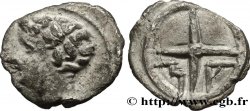bga_309951 - MASSALIA - MARSEILLE Obole MA, tête à droite - coiffure en cœur
Not available.
Item sold on our e-shop (2025)
Price : 150.00 €
Item sold on our e-shop (2025)
Price : 150.00 €
Type : Obole MA, tête à droite - coiffure en cœur
Date: c. 350-220 AC.
Mint name / Town : Marseille (13)
Metal : silver
Diameter : 10,5 mm
Orientation dies : 11 h.
Weight : 0,78 g.
Rarity : R1
Coments on the condition:
Flan un peu irrégulier, avec des types de droit et de revers presque complets. Patine grise
Catalogue references :
Obverse
Obverse legend : ANÉPIGRAPHE.
Obverse description : Tête juvénile d’Apollon à droite avec un début de favoris plus ou moins marqué, grènetis.
Reverse
Reverse legend : M-A DANS LES 3E ET 4E CANTONS.
Reverse description : Roue à quatre rayons avec moyeu central.
Commentary
Ces oboles de poids lourd, avec la tête à droite de très bon style sont classées dans le CMP. dans la période classique, et plus précisément entre 380 et 336.
Assez homogènes dans l’ensemble, ces monnaies peuvent être classées plus précisément selon la composition de la chevelure, la présence et la taille des favoris, la taille du moyeu central au revers, etc... ; avec une grande part de subjectivité !
Avec cette chevelure caractéristique, composée autour de deux mèches formant un cœur, ces oboles se rapprochent des CMP. 333 à 335.
Assez homogènes dans l’ensemble, ces monnaies peuvent être classées plus précisément selon la composition de la chevelure, la présence et la taille des favoris, la taille du moyeu central au revers, etc... ; avec une grande part de subjectivité !
Avec cette chevelure caractéristique, composée autour de deux mèches formant un cœur, ces oboles se rapprochent des CMP. 333 à 335.








 Report a mistake
Report a mistake Print the page
Print the page Share my selection
Share my selection Ask a question
Ask a question Consign / sell
Consign / sell
 Full data
Full data









